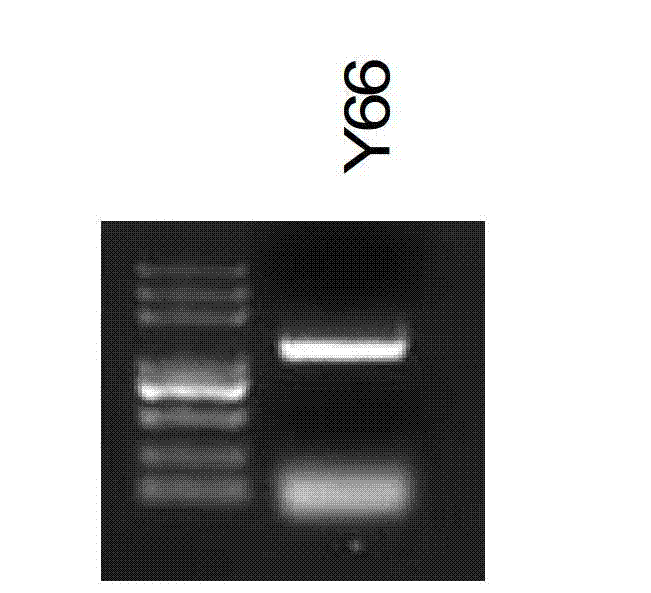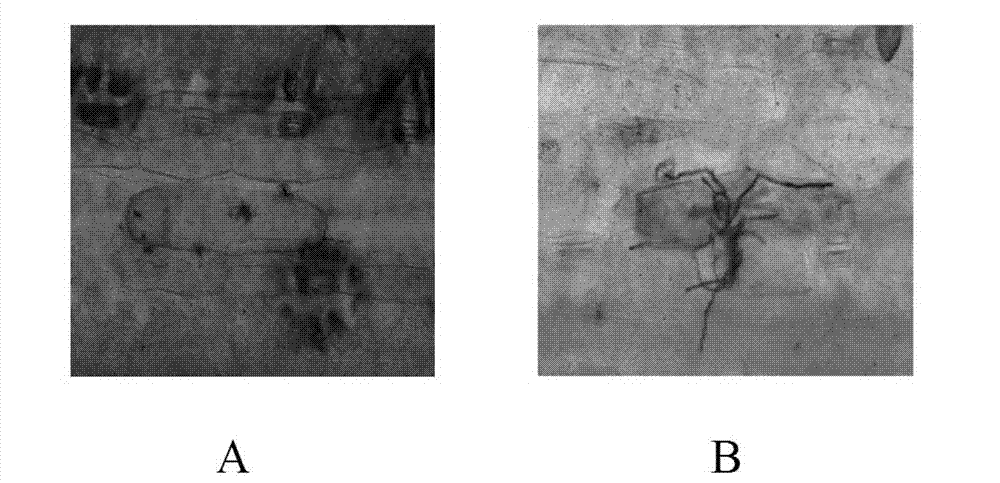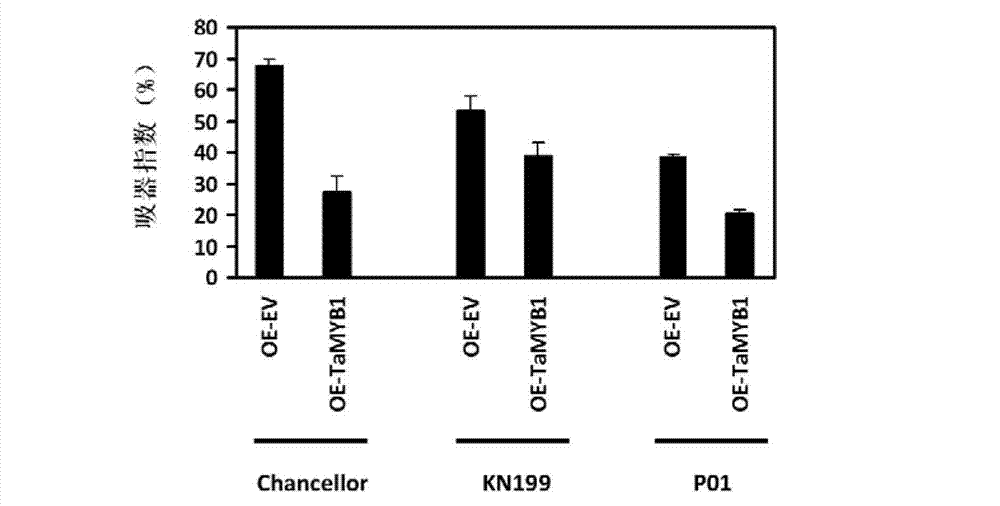Wheat protein TaMYB1, and coding gene and application thereof
A protein and gene technology, applied in the field of wheat protein TaMYB1 and its encoding gene and application, can solve the problems of fast mutation speed, loss of resistance of effective disease resistance genes, etc.
- Summary
- Abstract
- Description
- Claims
- Application Information
AI Technical Summary
Problems solved by technology
Method used
Image
Examples
Embodiment 1
[0049] Embodiment 1, the acquisition of TaMYB1 gene
[0050] 1. Obtaining RNA
[0051] Seven-day-old seedlings of wheat variety Yumai 66 were inoculated with E. tritici physiological race E09, collected for 24 hours, and RNA was extracted.
[0052] 2. Obtain cDNA by reverse transcription
[0053] Reverse transcription system:
[0054] RNA 2.5ul
[0055] Oligo-dT 1ul
[0056] DEPC-H 2 O 6.5ul
[0057] Mix the above solutions in a centrifuge tube, set at 70°C for 5 minutes, and place on ice for another 5 minutes.
[0058]
[0059] Continue to add the above solution into the centrifuge tube, incubate at 48°C for 1 hour, 70°C for 15 minutes, and 4°C for 10 minutes to obtain cDNA.
[0060] 3. Clone TaMYB1
[0061] Add the above cDNA to 25ul ddH 2 0, get 1ul to carry out follow-up PCR reaction as template, carry out PCR amplification with following primers,
[0062] F: AAATTTGGATCCATGTCACGGATCGGAGAT (sequence 3)
[0063] R: GGGCCTGTCGACTTATATTGAGTTACCATCAT (sequence 4)...
Embodiment 2
[0069] Embodiment 2, the application of TaMYB1 gene in powdery mildew resistance
[0070] 1. Preliminary identification of the resistance of TaMYB1 to powdery mildew by gene gun transient overexpression technology
[0071] 1. Carrier Construction
[0072] 1) Using the PCR product obtained in Example 1 (or artificially synthesized sequence 1) as a template, use the following primers F' and R' to perform PCR amplification to obtain a PCR product of about 1.2Kb.
[0073] F': GGGGACAAGTTTGTACAAAAAAGCAGGCTTCATGTCACGGATCGGAGAT
[0074] R': GGGGACCACTTTGTACAAGAAAGCTGGGTCTTATATTGAGTTACCATCAT
[0075] 2) Perform BP reaction with the above PCR product and pDNOR201 vector (purchased from Invitrogen Company) to obtain the ENTRY vector.
[0076] The above BP reaction system:
[0077] PCR product 75ng
[0078] pDNOR201 75ng
[0079] BPase 0.5ul
[0080] 25°C overnight.
[0081] 3) Perform LR reaction with the above ENTRY vector and pUBI-Adaptor-NOS vector to generate pUBI-TaMYB1 vec...
Embodiment 3
[0139] Example 3. Analysis of subcellular localization of TaMYB1 and expression pattern induced by powdery mildew
[0140] 1. Subcellular localization of TaMYB1
[0141] 1. Carrier Construction
[0142] 1) Using the PCR product obtained in Example 1 (or artificially synthesized sequence 1) as a template, PCR amplification was performed with the following primers F1 and R1 to obtain a PCR product of about 1.2 Kb.
[0143] F1: GGGGACAAGTTTGTACAAAAAAGCAGGCT-TC-ATGTCACGGATCGGAGAT
[0144] R1: GGGGACCACTTTGTACAAGAAAGCTGGGT-C-TATTGAGTTACCATCATGT
[0145] 2) Perform BP reaction with the above PCR product and pDNOR201 vector (purchased from Invitrogen) to obtain the ENTRY-1 vector.
[0146] The above BP reaction system:
[0147] PCR product 75ng
[0148] pDNOR201 75ng
[0149] BPase 0.5ul
[0150] 25°C overnight.
[0151] 3) React the above ENTRY-1 vector with pUbi-Gateway-eYFP vector LR to generate pUBI-TaMYB1-mYFP vector.
[0152] LR reaction system:
[0153] Intermediate ...
PUM
| Property | Measurement | Unit |
|---|---|---|
| Diameter | aaaaa | aaaaa |
Abstract
Description
Claims
Application Information
 Login to View More
Login to View More - R&D
- Intellectual Property
- Life Sciences
- Materials
- Tech Scout
- Unparalleled Data Quality
- Higher Quality Content
- 60% Fewer Hallucinations
Browse by: Latest US Patents, China's latest patents, Technical Efficacy Thesaurus, Application Domain, Technology Topic, Popular Technical Reports.
© 2025 PatSnap. All rights reserved.Legal|Privacy policy|Modern Slavery Act Transparency Statement|Sitemap|About US| Contact US: help@patsnap.com



